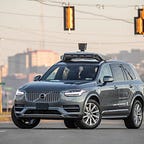Self-driving cars return to Pittsburgh roads in manual mode
At Uber, we believe that technology has the power to make transportation more efficient, accessible, and safer than ever before. Self-driving technology has the potential to make these benefits an everyday reality for our customers, but it’s not going to happen overnight. Building best-in-class self-driving technology will take time, and safety is our priority every step of the way.
After the tragedy in Tempe, we launched a top-to-bottom review of our self-driving program with a focus on safety. Today, we are taking a first step towards bringing our self-driving vehicles back to public roadways in Pittsburgh.
We’re starting with cars in manual mode, with a Mission Specialist sitting behind the wheel and manually controlling the vehicle at all times. Mission Specialists undergo extensive training to operate self-driving vehicles on our test track and on public roads. The Mission Specialist behind the wheel is primarily responsible for maintaining vehicle safety, while a second Specialist in the passenger seat will document notable events.
While things may look the same on the outside, we’ve identified and implemented safeguards that improve overall vehicle fleet safety and performance:
- Real-time Driver Monitoring: All of Uber’s self-driving vehicles will have a driver-monitoring system installed to help ensure Mission Specialists are remaining attentive behind the wheel. If the system detects inattentive behavior, an audio alert will cue the Mission Specialist. The system also alerts a remote monitor who will take appropriate action once they’ve assessed the situation. This system will remain active whenever the vehicle is in use.
- Collision Avoidance Systems: The built-in collision avoidance system is enabled, and will remain enabled during manual driving. The system activates emergency braking under certain conditions, such as a sudden change in traffic ahead of the vehicle, and provides imminent collision warnings to the Mission Specialist(s) in the vehicle.
- Minimizing Potential for Distraction from In-Vehicle Screens: All of our self-driving cars come equipped with a front tablet, designed in accordance with NHTSA’s Human Factors Design Guidance For Driver-Vehicle Interfaces, where turn-by-turn navigation and vehicle status information is displayed. We’ve re-reviewed this interface and modified certain features to further reduce potential distractions while the vehicle is in motion.
- Training & Policy Improvements: All Mission Specialists have completed new training modules specifically focused on safe manual driving. These modules include dedicated time in defensive and distracted driving courses, as well as improved test track situational awareness drills.
- Preparation for Duty Measures: All Mission Specialists undergo rigorous training prior to operating a self-driving vehicle, and are expected to uphold high levels of performance. We’ve enacted a fatigue management program including mandated switches between left- and right-seat operations throughout the duration of their shift.
While we are eager to resume testing of our self-driving system, we see manual driving as an important first step in piloting these safeguards. As we look to get back on the road in self-driving mode in the coming months, manually driven miles will improve our operations in the following ways:
- Virtual Simulation Scenario Generation: Manual driving allows us to see in real-time different scenarios that our self-driving cars will encounter on the road. We then recreate those scenarios in a virtual world, and on the test track, to improve overall system performance under similar conditions.
- Accurate HD Map Development: High quality HD maps power safe and reliable self-driving systems. Maintaining accurate maps is a continuous process, and more manual data collection means we can keep these maps up-to-date.
Self-driving technology has the potential to change how we move, reinvent how we design cities, and save lives. We recognize our responsibility to contribute to this future, and the essential role that safety plays as we move forward. We also recognize that transparency is critical to building trust, which is why we’ll continue to share our progress as we work towards getting back on the road in self-driving mode, as well as publish a Voluntary Safety Self-Assessment.
